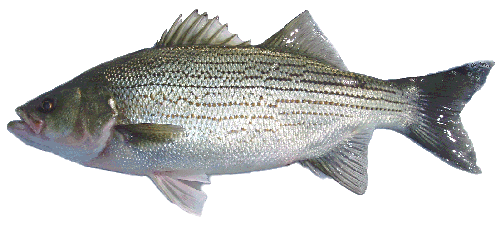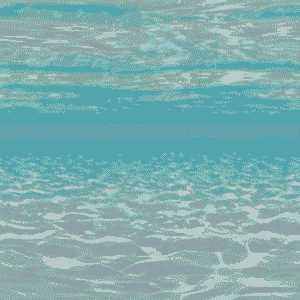
Hybrid Striped Bass
NJ Skillful Angler Qualifying weight is 8lbs.
Striped Bass Hybrid
( Morone saxatilis X Morone chrysops )

Hybrid Striped Bass
NJ Skillful Angler Qualifying weight is 8lbs.
Striped Bass Hybrid
( Morone saxatilis X Morone chrysops )
The striped bass hybrid has several nicknames, wipers, sunshine bass, whiterocks, rocket bass or just plan stripers. This continuing "Success Story" began back in October of 1985 when the KNEE DEEP CLUB stocked 1,000 12 to 15 inch hybrid striped bass into Lake Hopatcong. The striped bass hybrid is a cross between a male white bass and a female striped bass combining some features of both fish into one. Originally stocked to fill the gap created by our declining hold over trout population these fish have surpassed all expectations and have flourished to become an extremely exciting Trophy Class fishery. Our current Club Record catch of 10 pounds 13 ounces was made by Joe Crouch in 2001. These stripers grow remarkably fast in Lake Hopatcong. It's been my experience that the year following a major draw down has always been a banner year for really great fishing on Lake Hopatcong. If you're looking for some real TROPHY CLASS fishing, give our STRIPERS a try, they'll put a bend in the stiffest rod and put a strain on the smoothest drag, and if your line and knot hold up, you might catch a new State Record, in addition as an added bonus, if you're a KNEE DEEP CLUB member you could also win our $1,000.00 1st Prize to boot.
Bill Clark

"Rice Krispies"! Remember "Snap. Crackle, & Pop!? I sometimes call hybrid bass Rice Krispies because they snap so many lines, make the top of the water crackle as they tear drag from reels, or simply pop one-piece rods into two-piece outfits.
Old-time club members probably remember that the club first stocked Lake Hopatcong with hybrid bass way back in 1984. And from that beginning, a wonderful fishery has been produced in several venues in the Garden State. The New Jersey Division of Fish and Wildlife now stocks Hopatcong with them, and also puts four-inch fingerlings into the Manasquan Reservoir and Spruce Run Reservoir. But they put more into Lake Hopatcong than into the two others combined!
Called "stripers" by many anglers at Hopatcong, they are called by many other names all around the country. You see, there are 29 states in America that stock these wonderful fish. Down in Tennessee, many still call them "Cherokee" bass. That's because Cherokee Lake in Tennessee was the first place stocked with them. Created by the crossing of female striped bass roe and male white bass sperm, that's how and where it was started!
My favorite name for them is Rocket because of their ferocious strike and subsequent struggle, highlighted by sudden and tooth-jarring direction changes. They are called sunshine, wiper, and whiper elsewhere, along with striped bass hybrids.
Let's try to catch some at the biggest lake in the Garden State. There are a few times of the day that folks swear are the best at Hopatcong. Clearly, fellow hybrid nut-case, Dominic Sarinelli, likes to go after them right after the first sign of light appears. And there are many other anglers who swear that this is the best time of the day, when the big power boats are not on the lake, tearing it up.
Fishing early in the day often involves scouting as much as fishing. When the water is quiet, with no waves or wind, herring can be seen on top, feeding on plankton. This also takes place at the darkest time of daylight. You can actually see little ripples as the herring suck in the plankton. But now is where the scouting comes in.
A bit offshore of Brady's Bridge is one of the top early in the day spots where hybrid is taken. Those herring ripples you see will be interrupted from time to time by a gang of marauding hybrid bass, tearing through them, eating in the same manner as bluefish do down the Jersey shore. Hybrids can pop up just about anywhere in the lake early or late in the day, with the only pre-request being the need for the presence of herring up on top.
But for now, let's talk about the two times of the year that I do my most business in at the lake. Both involve less traffic and usually, far better action. And each requires a problem that is found all summer long in the lake to be gone.
That problem is called "Dissolved Oxygen". Come June, especially later in June, and clear through the summer, the lake has a dead zone. Dead, meaning that unless fish can swim around while wearing an oxygen tank, they will not be able to breathe below a certain level. In the peak of the summer, if you fish more than 15 feet down, chances are good that your bait will die within 30 seconds. And for sure, there won't be any fish feeding below that level for more than a brief moment.
So I do most of my business from early in May up to early June. And then I fish the whole month of October. At such times, the lake has perfectly good oxygen flowing throughout its entire depths. Sure, in the summer, fish a dozen feet down and you really have a good chance at scoring, because nothing is feeding much deeper than that. But if you want to really have a good shot at catching some Rockets in the lake, try this style.
Bertrand's Island and Pickerel Point are two popular places fished for hybrid bass. Ditto Davis Cove and Lee's Cove. But my two favorite spots are at Chestnut Point and across from it, Elba Point.
Let's try for hybrid bass off of Elba Point, say on the 10th of October, any year, okay? Presuming the wind isn't blowing too hard, and it's not too terribly sunny either, and that it's a weekday when the speedboat count is way down, try this.
Whether in your own boat or a Dow's or Lake's End rental, make certain you have a depth finder on board (there are very cheap portable models that you can hook up on a rental). Check your depth in a circle. Look for changing depths rather than flat bottom. Sure, you may find fish on the scope, but that's only a plus, this is not urgent, trust me.
Before you even launch, make sure you have two anchors on board with lots of extra line. You should have 125 feet or more for each anchor. If a rental with two anchors and not too much line, get permission first, of course, and then add in an extra length that you carry with you to each.
Set your bow inshore anchor first, in maybe 25 feet of water, and then slowly back up until just before you reach the end of the line. Put the engine into neutral, wait a brief moment, and now drop #2 overboard from the stern. If done right, this anchor should go into 40-45 feet of water. When it reaches bottom, pull the boat back to the bow anchor, trying to dig the stern anchor into bottom at the same time. If you are using those bazillion pound cement block anchors, you won't "dig in", but they still should hold you in place.
Pull each anchor line up tight and if correctly set up, you should have each anchor in bottom at least 40-50 feet away from you. Trust me; you will need this extra "scope" in case a Rocket launches itself into one of your baits. There is a 90% certainly that if you hook the fish, it will go over or under at least one of your two anchors and you will need that extra rope to manage to handle the lunatic at the other end of your pole.
You should be holding over 35-40 feet of water and once the oxygen problem is gone, you will be able to catch hybrid bass anywhere from 10 feet down, all the way to the bottom. In the spring, you will undoubtedly be "bothered" by trout, but come fall, most will have been caught so you may not catch any in October. But besides hybrid bass, you should count on the likelihood of catching walleye, yellow and white perch, a variety of catfish, plus smallies, crappie, and who knows what else at these times.
Remember, you are double-anchored, right? Sure, there may be fish visible on your scope. Fish at the level you read them, but to increase your chances, carry a plastic baggie or two of frozen herring with you, bait left over from previous trips. Cut three or four baits into chunks from time to time, scattering them all around the boat. You will attract catties, yes, but the flash of a fluttering chunk will often attract all the other critters. I clearly remember bringing a nice walleye to the top off of Chestnut Point one October day. And as it reached the surface, it burped up a half-dozen of the chunks that I had recently thrown over, and if that isn't proof, what is?
Most of your action will be found right at bottom. Use a ¾ ounce egg sinker, stopped by a barrel swivel, and attach a three foot leader to the other end of the swivel, and tie in a Mustad model 3906, size six hook. Bait up with herring, drop down, open your drag, and listen for that wonderful screech! But also make sure to have several rods rigged with slider-floats ("slip-bobbers"). Set one at 15 feet and another to settle down 25 feet below the surface. Many of your hybrid bites will come on these float-suspended baits, especially after you chuck out a few chunks of chum to attract the Rockets!
Scuze me gone fishin'
The book "Gone Fishin' .. For Hybrid Bass" can be purchased directly from Manny by sending $13.95 (+6% tax for Jersey residents) to: Manny Luftglass, Box 556, Annandale, N. J. 08801. Make sure to say that you are a Knee Deep Club member and $2 will be sent to the club for every check received from members.